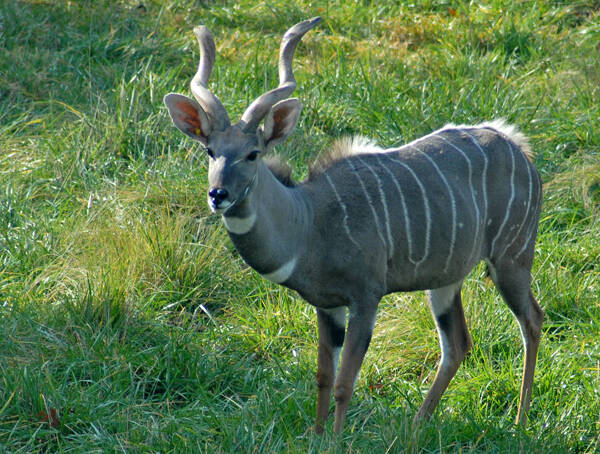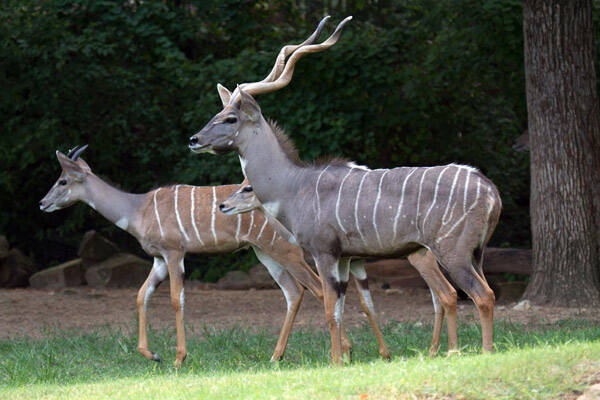Tragelaphus imberbis
IUCN
LCBasic Information
Scientific classification
- name:Tragelaphus imberbis
- Scientific Name:Tragelaphus imberbis
- Outline:Ungulata
- Family:Artiodactyla Bovidae Sapir
Vital signs
- length:110-175cm
- Weight:No verification information
- lifetime:About 15 years
Feature
Not good at running, fur has camouflage color
Distribution and Habitat
The small bushbuck is found in the semi-arid region of northeastern Africa, commonly known as the Somali-Maasai dry zone, located in Ethiopia, Somalia, Kenya, and Tanzania. Its range is from southern Awash in Ethiopia to southern Ethiopia, most of southern Somalia (46°E, 08°N), most of Kenya (except the southwest), southeastern tip of Sudan, northeastern Uganda to northeastern and central Tanzania. It is extinct in Djibouti.
The small bushbuck inhabits subtropical and tropical dry scrubland, inhabiting dry, flat, densely wooded areas, as well as woodlands and hilly areas. It is rarely observed in open or cleared land.
Appearance
The antelope is the largest antelope in the Arabian region. The head and body are 1.10-1.75 meters long, and the body is 0.90-1.05 meters tall. The tail is 0.26-0.30 meters long. Males have horns 4.8-9.1 cm long, with two longitudinal keels on the horns, twisted 2.5 times, and a circumference of 156-171 mm at the base of the horns. Males have a grayish coat of varying shades, with females noticeably more reddish-brown. There is a long white stripe running along the spine, and 11-14 stripes running longitudinally downward. The face has black stripes from the eyes to the nose, and white stripes from the eyes to the center of the face. The lip area is white, and there are four white spots on the lower jaw, two on each side. The legs have white spots above the hooves. The tail is brown, white on the underside and black at the tip. There are white patches on the throat and chest, and a black stripe across the chest. The abdomen is pure white. The fur color of young antelopes is similar to t
Details
Lesser Kudu (scientific name: Tragelaphus imberbis) is also known as Lesser Kudu in English. There are 2 subspecies.

Lesser Kudu is mainly nocturnal, foraging in the lush and dense jungle within a few hours after sunrise. They do not seem to be dependent on water sources, but do not usually live in waterless deserts. Females form small groups of 2 or 3, while males tend to remain solitary or occasionally form small groups. The average species density is rarely more than 1 individual per square kilometer, and the home range generally extends from 0.4 square kilometers to 6.7 square kilometers. However, territorial behavior does not exist. There are no hierarchical groups, and fighting is rare. When frightened, the small forest antelope will shake the leaves, similar to the warning given by antelopes. Jumping movements are common, with recorded heights exceeding 2 meters and reaching 9.2 meters in a single leap.
The small forest antelope reaches sexual maturity at 1.25-1.50 years of age, however, males do not gain breeding social status until they reach 4-5 years of age. During the breeding season, males engage in fighting contests, pressing their heads and horns together and trying to force their horns onto the back of their opponent's neck. Males and females also engage in dominance contests, with males and females raising their hind legs fully erect and trying to push each other off. The larger male usually wins. Males generally show restraint and never act aggressively toward females, although females have been observed confronting males. When males mount for mating, they place their necks and heads down on the back of the female. Each female has her own independent estrus cycle, which lasts only a few weeks. The gestation period varies from 7.5 to 8.0 months, after which the female leaves the group. Only one calf is born per litter, weighing 4.0-7.5 kg. 50% of young antelopes die from disease and predation within the first 6 months, and only 25% survive to over 3 years old. After 6-9 months of the first year, males begin to grow and reach adult size after 3 years. Young antelopes can live up to 15 years.

The small bushbuck has high requirements for living environment. They prefer to live in areas with lush vegetation, so that the species can withstand considerable hunting pressure. For example, throughout the Ogaden region, as long as there is sufficiently dense bush, despite the widespread uncontrolled hunting by local populations. On the other hand, their susceptibility to rinderpest led to a significant decline in their numbers in eastern Kenya in the mid-1990s. These populations are expected to recover after the rinderpest outbreak caused the species to decline. The range of the antelope is relatively small, and poaching has reached moderate or higher levels. Eradicating rinderpest will be an important step to reduce pressure on the species.
Conservation Action: An estimated one-third of the species population lives in protected areas. These populations occur in protected areas such as Awash, Omo and Mago National Parks (Ethiopia), Tsavo National Park (Kenya) and Ruaha National Park and adjacent game reserves (Tanzania), but there are larger numbers outside of protected areas. The long-term survival prospects of the antelope will be strengthened by improving conservation and management practices to improve areas where there are large numbers of the species and relatively few protected areas. In addition, their status as a valuable species gives them great potential for increasing regional benefits in large bush areas, and can increase the overall abundance of the species outside of national parks and equivalent reserves.
Listed in the 2016 Red List of Threatened Species of the World Conservation Union (IUCN) ver 3.1 - Near Threatened (NT).
Protect wild animals and eliminate game.
Maintaining ecological balance is everyone's responsibility!








